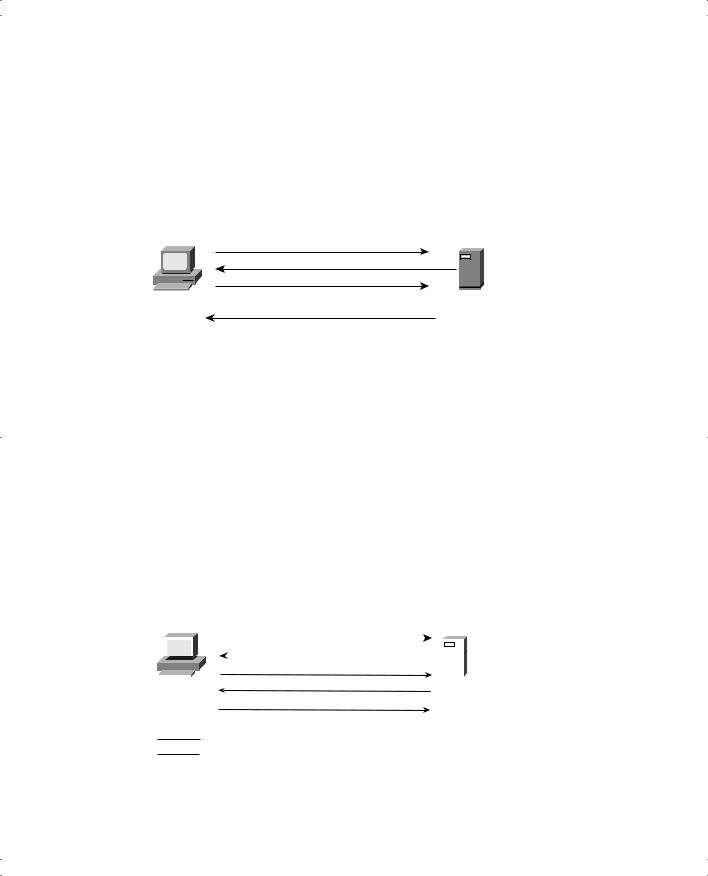
- •Warning and Disclaimer
- •Feedback Information
- •Trademark Acknowledgments
- •About the Author
- •About the Technical Reviewers
- •Dedication
- •Acknowledgments
- •Contents at a Glance
- •Contents
- •Icons Used in This Book
- •Command Syntax Conventions
- •Cisco’s Motivation: Certifying Partners
- •Format of the CCNA Exams
- •What’s on the CCNA Exams
- •ICND Exam Topics
- •Cross-Reference Between Exam Topics and Book Parts
- •CCNA Exam Topics
- •INTRO and ICND Course Outlines
- •Objectives and Methods
- •Book Features
- •How This Book Is Organized
- •Part I: LAN Switching
- •Part II: TCP/IP
- •Part III: Wide-Area Networks
- •Part IV: Network Security
- •Part V: Final Preparation
- •Part VI: Appendixes
- •How to Use These Books to Prepare for the CCNA Exam
- •For More Information
- •Part I: LAN Switching
- •“Do I Know This Already?” Quiz
- •Foundation Topics
- •Brief Review of LAN Switching
- •The Forward-Versus-Filter Decision
- •How Switches Learn MAC Addresses
- •Forwarding Unknown Unicasts and Broadcasts
- •LAN Switch Logic Summary
- •Basic Switch Operation
- •Foundation Summary
- •Spanning Tree Protocol
- •“Do I Know This Already?” Quiz
- •Foundation Topics
- •Spanning Tree Protocol
- •What IEEE 802.1d Spanning Tree Does
- •How Spanning Tree Works
- •Electing the Root and Discovering Root Ports and Designated Ports
- •Reacting to Changes in the Network
- •Spanning Tree Protocol Summary
- •Optional STP Features
- •EtherChannel
- •PortFast
- •Rapid Spanning Tree (IEEE 802.1w)
- •RSTP Link and Edge Types
- •RSTP Port States
- •RSTP Port Roles
- •RSTP Convergence
- •Edge-Type Behavior and PortFast
- •Link-Type Shared
- •Link-Type Point-to-Point
- •An Example of Speedy RSTP Convergence
- •Basic STP show Commands
- •Changing STP Port Costs and Bridge Priority
- •Foundation Summary
- •Foundation Summary
- •Virtual LANs and Trunking
- •“Do I Know This Already?” Quiz
- •Foundation Topics
- •Review of Virtual LAN Concepts
- •Trunking with ISL and 802.1Q
- •ISL and 802.1Q Compared
- •VLAN Trunking Protocol (VTP)
- •How VTP Works
- •VTP Pruning
- •Foundation Summary
- •Part II: TCP/IP
- •IP Addressing and Subnetting
- •“Do I Know This Already?” Quiz
- •Foundation Topics
- •IP Addressing Review
- •IP Subnetting
- •Analyzing and Interpreting IP Addresses and Subnets
- •Math Operations Used to Answer Subnetting Questions
- •Converting IP Addresses from Decimal to Binary and Back Again
- •The Boolean AND Operation
- •How Many Hosts and How Many Subnets?
- •What Is the Subnet Number, and What Are the IP Addresses in the Subnet?
- •Finding the Subnet Number
- •Finding the Subnet Broadcast Address
- •Finding the Range of Valid IP Addresses in a Subnet
- •Finding the Answers Without Using Binary
- •Easier Math with Easy Masks
- •Which Subnet Masks Meet the Stated Design Requirements?
- •What Are the Other Subnet Numbers?
- •Foundation Summary
- •“Do I Know This Already?” Quiz
- •Foundation Topics
- •Extended ping Command
- •Distance Vector Concepts
- •Distance Vector Loop-Avoidance Features
- •Route Poisoning
- •Split Horizon
- •Split Horizon with Poison Reverse
- •Hold-Down Timer
- •Triggered (Flash) Updates
- •RIP and IGRP
- •IGRP Metrics
- •Examination of RIP and IGRP debug and show Commands
- •Issues When Multiple Routes to the Same Subnet Exist
- •Administrative Distance
- •Foundation Summary
- •“Do I Know This Already?” Quiz
- •Foundation Topics
- •Link-State Routing Protocol and OSPF Concepts
- •Steady-State Operation
- •Loop Avoidance
- •Scaling OSPF Through Hierarchical Design
- •OSPF Areas
- •Stub Areas
- •Summary: Comparing Link-State and OSPF to Distance Vector Protocols
- •Balanced Hybrid Routing Protocol and EIGRP Concepts
- •EIGRP Loop Avoidance
- •EIGRP Summary
- •Foundation Summary
- •“Do I Know This Already?” Quiz
- •Foundation Topics
- •Route Summarization and Variable-Length Subnet Masks
- •Route Summarization Concepts
- •VLSM
- •Route Summarization Strategies
- •Sample “Best” Summary on Seville
- •Sample “Best” Summary on Yosemite
- •Classless Routing Protocols and Classless Routing
- •Classless and Classful Routing Protocols
- •Autosummarization
- •Classful and Classless Routing
- •Default Routes
- •Classless Routing
- •Foundation Summary
- •Advanced TCP/IP Topics
- •“Do I Know This Already?” Quiz
- •Foundation Topics
- •Scaling the IP Address Space for the Internet
- •CIDR
- •Private Addressing
- •Network Address Translation
- •Static NAT
- •Dynamic NAT
- •Overloading NAT with Port Address Translation (PAT)
- •Translating Overlapping Addresses
- •Miscellaneous TCP/IP Topics
- •Internet Control Message Protocol (ICMP)
- •ICMP Echo Request and Echo Reply
- •Destination Unreachable ICMP Message
- •Time Exceeded ICMP Message
- •Redirect ICMP Message
- •Secondary IP Addressing
- •FTP and TFTP
- •TFTP
- •MTU and Fragmentation
- •Foundation Summary
- •Part III: Wide-Area Networks
- •“Do I Know This Already?” Quiz
- •Foundation Topics
- •Review of WAN Basics
- •Physical Components of Point-to-Point Leased Lines
- •Data-Link Protocols for Point-to-Point Leased Lines
- •HDLC and PPP Compared
- •Looped Link Detection
- •Enhanced Error Detection
- •Authentication Over WAN Links
- •PAP and CHAP Authentication
- •Foundation Summary
- •“Do I Know This Already?” Quiz
- •Foundation Topics
- •ISDN Protocols and Design
- •Typical Uses of ISDN
- •ISDN Channels
- •ISDN Protocols
- •ISDN BRI Function Groups and Reference Points
- •ISDN PRI Function Groups and Reference Points
- •BRI and PRI Encoding and Framing
- •PRI Encoding
- •PRI Framing
- •BRI Framing and Encoding
- •DDR Step 1: Routing Packets Out the Interface to Be Dialed
- •DDR Step 2: Determining the Subset of the Packets That Trigger the Dialing Process
- •DDR Step 3: Dialing (Signaling)
- •DDR Step 4: Determining When the Connection Is Terminated
- •ISDN and DDR show and debug Commands
- •Multilink PPP
- •Foundation Summary
- •Frame Relay
- •“Do I Know This Already?” Quiz
- •Foundation Topics
- •Frame Relay Protocols
- •Frame Relay Standards
- •Virtual Circuits
- •LMI and Encapsulation Types
- •DLCI Addressing Details
- •Network Layer Concerns with Frame Relay
- •Layer 3 Addressing with Frame Relay
- •Frame Relay Layer 3 Addressing: One Subnet Containing All Frame Relay DTEs
- •Frame Relay Layer 3 Addressing: One Subnet Per VC
- •Frame Relay Layer 3 Addressing: Hybrid Approach
- •Broadcast Handling
- •Frame Relay Service Interworking
- •A Fully-Meshed Network with One IP Subnet
- •Frame Relay Address Mapping
- •A Partially-Meshed Network with One IP Subnet Per VC
- •A Partially-Meshed Network with Some Fully-Meshed Parts
- •Foundation Summary
- •Part IV: Network Security
- •IP Access Control List Security
- •“Do I Know This Already?” Quiz
- •Foundation Topics
- •Standard IP Access Control Lists
- •IP Standard ACL Concepts
- •Wildcard Masks
- •Standard IP ACL: Example 2
- •Extended IP Access Control Lists
- •Extended IP ACL Concepts
- •Extended IP Access Lists: Example 1
- •Extended IP Access Lists: Example 2
- •Miscellaneous ACL Topics
- •Named IP Access Lists
- •Controlling Telnet Access with ACLs
- •ACL Implementation Considerations
- •Foundation Summary
- •Part V: Final Preparation
- •Final Preparation
- •Suggestions for Final Preparation
- •Preparing for the Exam Experience
- •Final Lab Scenarios
- •Scenario 1
- •Scenario 1, Part A: Planning
- •Solutions to Scenario 1, Part A: Planning
- •Scenario 2
- •Scenario 2, Part A: Planning
- •Solutions to Scenario 2, Part A: Planning
- •Part VI: Appendixes
- •Glossary
- •Answers to the “Do I Know This Already?” Quizzes and Q&A Questions
- •Chapter 1
- •“Do I Know This Already?” Quiz
- •Chapter 2
- •“Do I Know This Already?” Quiz
- •Chapter 3
- •“Do I Know This Already?” Quiz
- •Chapter 4
- •“Do I Know This Already?” Quiz
- •Chapter 5
- •“Do I Know This Already?” Quiz
- •Chapter 6
- •“Do I Know This Already?” Quiz
- •Chapter 7
- •“Do I Know This Already?” Quiz
- •Chapter 8
- •“Do I Know This Already?” Quiz
- •Chapter 9
- •“Do I Know This Already?” Quiz
- •Chapter 10
- •“Do I Know This Already?” Quiz
- •Chapter 11
- •“Do I Know This Already?” Quiz
- •Chapter 12
- •“Do I Know This Already?” Quiz
- •Using the Simulation Software for the Hands-on Exercises
- •Accessing NetSim from the CD
- •Hands-on Exercises Available with NetSim
- •Scenarios
- •Labs
- •Listing of the Hands-on Exercises
- •How You Should Proceed with NetSim
- •Considerations When Using NetSim
- •Routing Protocol Overview
- •Comparing and Contrasting IP Routing Protocols
- •Routing Through the Internet with the Border Gateway Protocol
- •RIP Version 2
- •The Integrated IS-IS Link State Routing Protocol
- •Summary of Interior Routing Protocols
- •Numbering Ports (Interfaces)

Miscellaneous TCP/IP Topics 285
Example 8-5 Secondary IP Addressing Configuration and the show ip route Command on Yosemite
! Excerpt from show running-config follows...
Hostname Yosemite ip domain-lookup
ip name-server 10.1.1.100 10.1.2.100 interface ethernet 0
ip address 10.1.7.252 255.255.255.0 secondary ip address 10.1.2.252 255.255.255.0
interface serial 0
ip address 10.1.128.252 255.255.255.0 interface serial 1
ip address 10.1.129.252 255.255.255.0
Yosemite# show ip route
Codes: C - connected, S - static, I - IGRP, R - RIP, M - mobile, B - BGP
D - EIGRP, EX - EIGRP external, O - OSPF, IA - OSPF inter area
N1 - OSPF NSSA external type 1, N2 - OSPF NSSA external type 2
E1 - OSPF external type 1, E2 - OSPF external type 2, E - EGP
i - IS-IS, L1 - IS-IS level-1, L2 - IS-IS level-2, ia - IS-IS inter area * - candidate default, U - per-user static route, o - ODR
P - periodic downloaded static route
Gateway of last resort is not set
10.0.0.0/24 is subnetted, 4 subnets
C10.1.2.0 is directly connected, Ethernet0
C10.1.7.0 is directly connected, Ethernet0
C10.1.129.0 is directly connected, Serial1
C10.1.128.0 is directly connected, Serial0 Yosemite#
The router has routes to subnets 10.1.2.0/24 and 10.1.7.0/24, so it can forward packets to each subnet. The router also can receive packets from hosts in one subnet and can forward them to the other subnet using the same interface.
FTP and TFTP
File Transfer Protocol (FTP) and Trivial File Transfer Protocol (TFTP) are two popularly used file transfer protocols in a typical IP network. Most end users use FTP, but Cisco router and switch administrators often use TFTP. Which is “better” depends partially on what is being done. A more important question might be, “Which is supported on the devices that need to transfer the file?” Given the choice today, most end users choose FTP because it has more robust features. However, Cisco IOS software did not originally support FTP for moving files in and out of the router, so many people continue to use TFTP out of habit.

286 Chapter 8: Advanced TCP/IP Topics
FTP
FTP is a TCP-based application that has many options and features, including the capability to change directories, list files using wildcard characters, transfer multiple files with a single command, and use a variety of character sets or file formats. More important in this context is the basic operation of FTP. Figures 8-16 and 8-17 show a typical FTP connection—or, better stated, connections.
Figure 8-16 FTP Control Connection
SYN, DPORT=21, SPORT=1030, No Data
SYN, ACK, DPORT=1030, SPORT=21, No Data 
ACK, DPORT=21, SPORT=1030, No Data
FTP Client |
FTP Server |
ACK, DPORT = 1030, SPORT = 21, ‘Username:’
The connection shown in Figure 8-16 is called an FTP control connection. When a user (FTP client) asks to connect to an FTP server, a TCP connection is established to the FTP server’s well-known port (21). The connection is established like any other TCP connection. The user typically is required to enter a username and password, which the server uses to authenticate the files available to that user for read and write permissions. This security is based on the file security on the server’s platform. All the commands used to control the transfer of a file are sent across this connection—hence the name FTP control connection.
At this point, the user has a variety of commands available to enable settings for transfer, change directories, list files, and so forth. However, whenever a get or put command is entered (or mget or mput—m is for multiple) or the equivalent button is clicked on the user interface, a file is transferred. The data is transferred over a separate FTP data connection. Figure 8-17 outlines the FTP data connection process.
Figure 8-17 FTP Data Connection
|
|
|
|
|
|
|
get, myport=1031, file=zzz |
|
|
|
|
|
|
|
|
|
|
|
|
TCP ACK |
|
|
|
|
|
|
|
|
|
|
|
|
|
|
|
|
|
|
|
|
|
|
|
|
|
SYN, DPORT=20, SPORT=1031 |
|
|
|
|
|
|
|
|
|
|
|
|
|
|
|
|
||
|
|
|
|
|
|
|
SYN, ACK, DPORT=1031, SPORT=20 |
|
|
|
|
|
FTP Client |
|
|
FTP Server |
|||||||||
|
|
|
|
|
|
|
ACK, DPORT=20, SPORT=1031 |
|
|
|
|
|
Represents New FTP Data Connection
Represents FTP Control Connection

Miscellaneous TCP/IP Topics 287
As shown in Figure 8-17, another TCP connection is established for the actual data transfer, this time to well-known port 20. Using this convention, a file can be transferred without getting in the way of the control connection. If many files are to be transferred rather than making a single control/data connection for each file, the control connection is made once. The environment is defined using the control connection, and these settings affect the functioning of the data connection. For example, the default directory to use in future transfers can be defined using commands on the control connection as well as the type of data (binary or ASCII). You might choose to use binary when transferring text files between computers that might use slightly different ASCII character sets but use binary to transfer executable files. The control connection stays up until the user breaks it or the connection times out. While the control connection is up, a separate data connection is established for each file transfer.
An additional step helps prevent hackers from breaking in and transferring files, as shown in Figure 8-17. Rather than just creating a new connection, the client tells the server, with an application layer message over the control connection, which port number will be used for the new data connection. The server does not transfer the file (zzz in this case) over any other data connection except the one to the correct socket—the one with the client’s IP address, TCP, and the port number declared to the server (1031 in this case).
TFTP
Trivial File Transfer Protocol (TFTP) performs basic file transfer with a small set of features. One of the reasons that such an application is needed, even when the more robust FTP is available, is that TFTP takes little memory to load and little time to program. With the advent of extremely low-cost memory and processing, such advantages seem trivial. Practically speaking, if you intend to frequently transfer files from your PC, you probably will use FTP. However, Cisco has supported TFTP for a much longer time, and many people still use it.
TFTP uses User Datagram Protocol (UDP), so there is no connection establishment and no error recovery by the transport layer. However, TFTP uses application layer recovery by embedding a small header between the UDP header and the data. This header includes codes—for example, read, write, and acknowledgment—along with a numbering scheme that numbers 512-byte blocks of data. The TFTP application uses these block numbers to acknowledge receipt and resend the data. TFTP sends one block and waits on an acknowledgment before sending another block.
